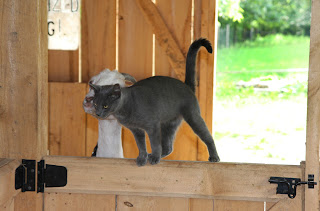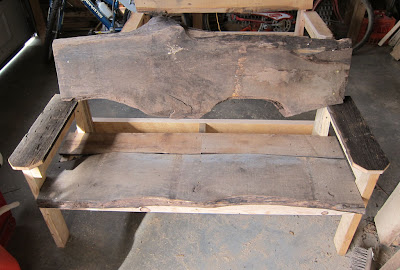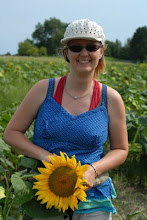 Found and photographed alongside Cayuga Lake last summer...
Found and photographed alongside Cayuga Lake last summer...
Tuesday, February 14, 2012
Saturday, February 11, 2012
Everybody loves our goats!
Since late spring last year we have a new cat who lives down in the barn. It's been a blessing, I actually was already checking the SPCA about barn cats, as we now have no rats or mice down there for only a handful of crunchies each day! Now all we need is a cat who does not mind living with the chickens and geese LOL
I named him Casper as in Casper the friendly ghost, since initially we'd only see a blur, running away fast. By accident I caught him in a live trap - I was going for gopher - and had him checked out by the SPCA. If you catch a feral cat and drop him off, they'll spay/neuter for free if you take it back!
Casper really took to the goats and below is hugging our laMancha Gazelle. He will give all three goats face huggs when he can, and by the time it turned Fall he now also wants his own huggies from us. It took about six months but now he's about as snuggly as any cat I've known!
 "I like you sooo much!"
"I like you sooo much!"
 "You're my favorite!"
"You're my favorite!"
I named him Casper as in Casper the friendly ghost, since initially we'd only see a blur, running away fast. By accident I caught him in a live trap - I was going for gopher - and had him checked out by the SPCA. If you catch a feral cat and drop him off, they'll spay/neuter for free if you take it back!
Casper really took to the goats and below is hugging our laMancha Gazelle. He will give all three goats face huggs when he can, and by the time it turned Fall he now also wants his own huggies from us. It took about six months but now he's about as snuggly as any cat I've known!
 "I like you sooo much!"
"I like you sooo much!" "You're my favorite!"
"You're my favorite!"
Friday, February 10, 2012
more garden benches
Still working away on my Pony Project (tho Icelandics are traditionally called Horses, of course) and with all the moving around of our wood was inspired to make two more garden benches. One with the last bit of water damaged black walnut and one with the newly milled sugar maple from our back yard. I think we might have maybe for two more benches in materials and then we're out... and the nice thing of making these benches? If they don't sell I get to keep them :)
From the craigslist ads:
 natural edge sugar maple garden bench - $150 (Ithaca)
natural edge sugar maple garden bench - $150 (Ithaca)
garden bench made with sustainable materials
ready to be placed outdoors and weather, or to sand down and stain
The natural edge wood is sugar maple, milled from a wind storm felled tree in our back yard. The frame is made from pine shipping wood and local hemlock
The bench is the size of a love seat, about 54 inches wide with arm rests of rounded edge sugar maple and a perfect angle back rest.
 natural edge walnut garden bench - $150 (Ithaca)
natural edge walnut garden bench - $150 (Ithaca)
garden bench made with sustainable materials
ready to be placed outdoors and weather, or to sand down and stain
The natural edge wood is very likely to be black walnut (those boards are from a dwindling supply of water damaged wood, hence this project). The frame is made from pine shipping wood and local hemlock.
The bench is the size of a love seat, about 54 inches wide with arm rests of old weathered barn wood and a perfect angle back rest.
From the craigslist ads:
 natural edge sugar maple garden bench - $150 (Ithaca)
natural edge sugar maple garden bench - $150 (Ithaca)garden bench made with sustainable materials
ready to be placed outdoors and weather, or to sand down and stain
The natural edge wood is sugar maple, milled from a wind storm felled tree in our back yard. The frame is made from pine shipping wood and local hemlock
The bench is the size of a love seat, about 54 inches wide with arm rests of rounded edge sugar maple and a perfect angle back rest.
 natural edge walnut garden bench - $150 (Ithaca)
natural edge walnut garden bench - $150 (Ithaca)garden bench made with sustainable materials
ready to be placed outdoors and weather, or to sand down and stain
The natural edge wood is very likely to be black walnut (those boards are from a dwindling supply of water damaged wood, hence this project). The frame is made from pine shipping wood and local hemlock.
The bench is the size of a love seat, about 54 inches wide with arm rests of old weathered barn wood and a perfect angle back rest.
Friday, February 3, 2012
How to keep a milk lye mixture cool
Which is actually surprisingly easy: just freeze the milk :)
Why would you need to keep the milk/lye mixture cool? For one, the heat will change the color of the milk from milky white to bright hunter orange and that color will transfer to the finished soap. So unless you make bright orange soap, the burnt milk will throw off your finished product's color at least a little.
But also, burnt milk means the heat broke down all the good stuff (you know, vitamins, minerals...) that are part of the milk - and which are actually why you want to use milk to begin with. Which means soap made with orange milk/lye is not of as good a quality as soap made with cooled down milk/lye.
How do I keep my milk/lye cool? I measure my milk beforehand (in fluid ounces, as milk is heavier than water) and store it in ziplock baggies in the freezer. Since my recipes are pretty much tailored to my crockpot that means I mostly use 32 fl oz of milk at a time.
When my oil and fat mixture is to temperature, between 100-120 degree F depending on the fats used (some need more heat to melt first and then I place the crockpot directly on the concrete basement floor to cool down) I take out a baggie of milk from the freezer. I run the baggie under a hot tap to release it from the inside, and to create some moisture to start the dilution process. I also use a little bit of water to rinse the milk residue out of the baggie and pour that over the frozen milk, which wets the chunk and gives some starter fluid in the tub to stir (but is not necessary).
I place the chunk of frozen milk in a plastic tub and make sure the outside of the frozen milk is wet (if you let it sit a bit it will freeze up again). Then I sprinkle a layer of lye crystals over the chunk and stir constantly (no splattering!) to prevent any one place from heating up. The heat of the lye will melt the frozen milk, so whenever the lye sluices off I add more crystals. It takes me about 20 minutes in all to slowly but steadily add the lye to the milk and most times only have a little frozen chunk left which will melt on it's own (but keep stirring).
 Do's and don't's of the milk/lye mixture:
Do's and don't's of the milk/lye mixture:
- Never let it sit (to heat up or cool down) as the fats of the milk will saponify.
- Keep stirring, as milk does not transfer heat as easily as water; it will build up heat locally and thus burn that area of milk (mixture turns first yellow then orange if you're really not paying attention).
- Add lye crystals steadily but slowly, no sense in hurrying as you have to wait for the frozen milk to completely melt anyway.
If the milk/lye looks off white or slightly green (like whey) the temps are around 80-90 degree F. If the milk is turning pale yellow to yellow it's closer to 90-100 degree F. I have not temped orange milk/lye yet, as that happened once (my first, uninformed, attempt at milk soap) and have tried my all to never have that happen again!
I also started to freeze other liquids like coffee, tea, apple cider, wine etc to be able to make low heat lye mixtures as these liquids also have ingredients like vitamins which you'd like to retain to work for you in your soaps.
The best thing about low heat lye mixtures? Hardly any caustic fumes! I do turn on my (darkroom) fan and wear a gas mask, but that's more for just in case than really needed, seems like.
Why would you need to keep the milk/lye mixture cool? For one, the heat will change the color of the milk from milky white to bright hunter orange and that color will transfer to the finished soap. So unless you make bright orange soap, the burnt milk will throw off your finished product's color at least a little.
But also, burnt milk means the heat broke down all the good stuff (you know, vitamins, minerals...) that are part of the milk - and which are actually why you want to use milk to begin with. Which means soap made with orange milk/lye is not of as good a quality as soap made with cooled down milk/lye.
How do I keep my milk/lye cool? I measure my milk beforehand (in fluid ounces, as milk is heavier than water) and store it in ziplock baggies in the freezer. Since my recipes are pretty much tailored to my crockpot that means I mostly use 32 fl oz of milk at a time.
When my oil and fat mixture is to temperature, between 100-120 degree F depending on the fats used (some need more heat to melt first and then I place the crockpot directly on the concrete basement floor to cool down) I take out a baggie of milk from the freezer. I run the baggie under a hot tap to release it from the inside, and to create some moisture to start the dilution process. I also use a little bit of water to rinse the milk residue out of the baggie and pour that over the frozen milk, which wets the chunk and gives some starter fluid in the tub to stir (but is not necessary).
I place the chunk of frozen milk in a plastic tub and make sure the outside of the frozen milk is wet (if you let it sit a bit it will freeze up again). Then I sprinkle a layer of lye crystals over the chunk and stir constantly (no splattering!) to prevent any one place from heating up. The heat of the lye will melt the frozen milk, so whenever the lye sluices off I add more crystals. It takes me about 20 minutes in all to slowly but steadily add the lye to the milk and most times only have a little frozen chunk left which will melt on it's own (but keep stirring).
 Do's and don't's of the milk/lye mixture:
Do's and don't's of the milk/lye mixture:- Never let it sit (to heat up or cool down) as the fats of the milk will saponify.
- Keep stirring, as milk does not transfer heat as easily as water; it will build up heat locally and thus burn that area of milk (mixture turns first yellow then orange if you're really not paying attention).
- Add lye crystals steadily but slowly, no sense in hurrying as you have to wait for the frozen milk to completely melt anyway.
If the milk/lye looks off white or slightly green (like whey) the temps are around 80-90 degree F. If the milk is turning pale yellow to yellow it's closer to 90-100 degree F. I have not temped orange milk/lye yet, as that happened once (my first, uninformed, attempt at milk soap) and have tried my all to never have that happen again!
I also started to freeze other liquids like coffee, tea, apple cider, wine etc to be able to make low heat lye mixtures as these liquids also have ingredients like vitamins which you'd like to retain to work for you in your soaps.
The best thing about low heat lye mixtures? Hardly any caustic fumes! I do turn on my (darkroom) fan and wear a gas mask, but that's more for just in case than really needed, seems like.
Wednesday, February 1, 2012
Glycerin?
Something neat I thought I'd share:
 What you see here is a raw soap mix, as in the oils & fats are chemically altered by the lye (saponified) to form soap, stirred with a hand blender. While blending something really neat happens on the surface: the formation of pure glycerin!
What you see here is a raw soap mix, as in the oils & fats are chemically altered by the lye (saponified) to form soap, stirred with a hand blender. While blending something really neat happens on the surface: the formation of pure glycerin!
In commercially processed soap the glycerin formed in the saponification process is separated from the main soap to be sold separately, leaving the soap itself more harsh. Which is exactly why any hand made cold process soap is immediately nicer in use than commercial soap as the naturally occurring glycerin is still in the bar.
 Here I stopped blending and the glycerin whirlpool sinks / absorbs back into the soap mix. This particular mix is Lye Soap, made with local organic lard and well water.
Here I stopped blending and the glycerin whirlpool sinks / absorbs back into the soap mix. This particular mix is Lye Soap, made with local organic lard and well water.
 What you see here is a raw soap mix, as in the oils & fats are chemically altered by the lye (saponified) to form soap, stirred with a hand blender. While blending something really neat happens on the surface: the formation of pure glycerin!
What you see here is a raw soap mix, as in the oils & fats are chemically altered by the lye (saponified) to form soap, stirred with a hand blender. While blending something really neat happens on the surface: the formation of pure glycerin!In commercially processed soap the glycerin formed in the saponification process is separated from the main soap to be sold separately, leaving the soap itself more harsh. Which is exactly why any hand made cold process soap is immediately nicer in use than commercial soap as the naturally occurring glycerin is still in the bar.
 Here I stopped blending and the glycerin whirlpool sinks / absorbs back into the soap mix. This particular mix is Lye Soap, made with local organic lard and well water.
Here I stopped blending and the glycerin whirlpool sinks / absorbs back into the soap mix. This particular mix is Lye Soap, made with local organic lard and well water.
 Although we have some sort of root cellar downstairs (the cement cubby where the well connects to the basement) it's damp so not that good for apples etc. With normal winter weather we've had great success keeping all the pumpkins, pears and apples in our sunroom - an unheated concrete floor east facing room, which does get below freezing if it's really cold outside, but also tends to cool down and heat up fairly tempered.
Although we have some sort of root cellar downstairs (the cement cubby where the well connects to the basement) it's damp so not that good for apples etc. With normal winter weather we've had great success keeping all the pumpkins, pears and apples in our sunroom - an unheated concrete floor east facing room, which does get below freezing if it's really cold outside, but also tends to cool down and heat up fairly tempered.But this year, with the 50 degree sunny days our storage is going fast! I sure hope we'll last till March - most years we can still feed the girls some sort of funny looking apples & pumpkins but don't think this will be one of those years. On the other hand, it also means there is not much snow on the ground which helps foraging and stuff should start to grow pretty soon - unless we get a late winter to make up for the delay...
Subscribe to:
Posts (Atom)





